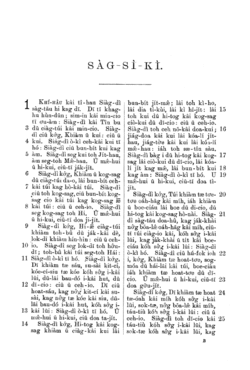Hainanese
| Hainanese | |
|---|---|
| Qiong wen | |
| 海南話 Hái-nâm-oe | |
| Pronunciation | [hai˨˩˧ nam˨˩ ue˨˧] (Haikou dialect) |
| Native to | China, United States (New York City, California), Taiwan, Malaysia, Indonesia, Singapore, Hong Kong, Macau |
| Region | Hainan |
| Ethnicity | Hainanese (Han Chinese) |
Native speakers | Around 5 million in China (2002)[1] |
| Language codes | |
| ISO 639-3 |
None (mis) |
| Glottolog |
hain1237[3]hain1238[4] |
|
Hainanese | |

Hainanese (Hainan Romanised: Hái-nâm-oe, simplified Chinese: 海南话; traditional Chinese: 海南話; pinyin: Hǎinán huà), also known as Qióng Wén (simplified Chinese: 琼文; traditional Chinese: 瓊文) or Qióng yǔ (瓊語/琼语), is a group of Min Chinese varieties spoken in the southern Chinese island province of Hainan. In the classification of Yuan Jiahua, it was included in the Southern Min group, though is mutually unintelligible with Southern Min varieties such as Teochew and Hokkien–Taiwanese. In the classification of Li Rong, used by the Language Atlas of China, it was treated as a separate Min subgroup.[5] It is sometimes combined with Leizhou Min, spoken on the neighboring mainland Leizhou Peninsula, in a Qiong–Lei group.[2] "Hainanese" is also used for the language of the Li people living in Hainan, but generally refers to Min varieties spoken in Hainan.
Phonology
Hainanese has a simple vowel system .
| Front | Back | |
|---|---|---|
| Close | /i/ | /u/ |
| Close-mid | /e/ | /o/ |
| Open-mid | /ɛ/ | /ɔ/ |
| Open | /a/ |
Hainanese notably has a series of implosive consonants, which it acquired through contact with surrounding languages, probably Hlai.
| Labial | Dental | Alveolo-palatal | Velar | Glottal | ||
|---|---|---|---|---|---|---|
| Plosive | voiceless | /p/ | /t/ | /k/ | (/ʔ/) | |
| voiced/implosive | /ɓ/ | /ɗ/ | (/ɠ/) | |||
| Affricate | /c/ [ts~tɕ] | |||||
| Fricative | voiceless | /f/ | /s/ [s~ɕ] | /x/ | /h/ | |
| voiced | /v/ | /ʑ/ [z~ʑ] | /ɦ/ | |||
| Nasal | /m/ | /n/ | /ŋ/ | |||
| Approximant | (/w/) | /l/ | (/j/) | |||
The phonological system of Hainanese corresponds well with that of Hokkien, but it has had some restructuring. In particular, etymological *anterior plain stops have undergone implosivization (*p > [ɓ], *t > [ɗ], etymological *aspirated stops have spirantized (*pʰ > [f], *tʰ > [h], *cʰ > [ɕ] *kʰ > [x]), and etymological *s have hardened into stops (*s > [t]), and *h > [f]. Additionally, some dialects have [ɡ], and [ʑ] is allophonic with /j/.
References
- ↑ Hou Jingyi [侯精一]. 2002. An Introduction to Modern Chinese Dialects [现代汉语方言概论], Shanghai Educational Press [上海教育出版社], pp. 207–208
- 1 2 Hou Jingyi [侯精一]. 2002. An Introduction to Modern Chinese Dialects [现代汉语方言概论], Shanghai Educational Press [上海教育出版社], p. 238
- ↑ Nordhoff, Sebastian; Hammarström, Harald; Forkel, Robert; Haspelmath, Martin, eds. (2013). "Hainanese". Glottolog. Leipzig: Max Planck Institute for Evolutionary Anthropology.
- ↑ Nordhoff, Sebastian; Hammarström, Harald; Forkel, Robert; Haspelmath, Martin, eds. (2013). "Hainan". Glottolog. Leipzig: Max Planck Institute for Evolutionary Anthropology.
- ↑ Kurpaska, Maria (2010). Chinese Language(s): A Look Through the Prism of "The Great Dictionary of Modern Chinese Dialects". Walter de Gruyter. pp. 54–55, 86. ISBN 978-3-11-021914-2.
Further reading
- Solnit, David B. (1982). "Linguistic Contact in Ancient South China: The Case of Hainan Chinese, Be, and Vietnamese". Proceedings of the Eighth Annual Meeting of the Berkeley Linguistics Society 8: 219–230.
External links
| Wikimedia Commons has media related to Hainan language. |
| ||||||||||||||||||||||||||||||||||||||||||||||||||||||||||||||||||||||||||||||||||||||||||||||
